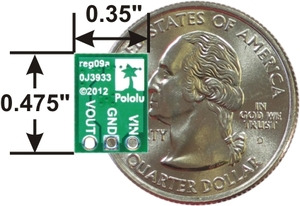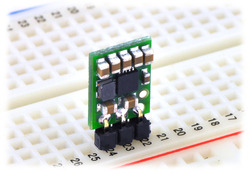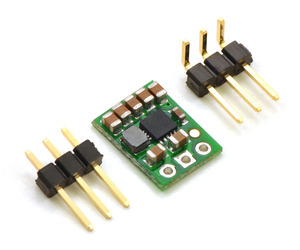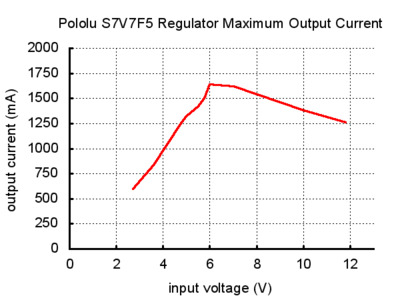

Pololu 5V Step-Up/Step-Down Voltage Regulator S7V7F5
The S7V7F5 switching step-up/step-down regulator efficiently produces 5 V from input voltages between 2.7 V and 11.8 V. Its ability to convert both higher and lower input voltages makes it useful for applications where the power supply voltage can vary greatly, as with batteries that start above but discharge below 5 V. The very compact (0.35" A— 0.475") module has a typical efficiency of over 90% and can supply up to 1 A when stepping down and about 500 mA when stepping up.
 |
The Pololu step-up/step-down voltage regulator S7V7F5 is a switching regulator (also called a switched-mode power supply (SMPS) or DC-to-DC converter) that uses a buck-boost topology. It takes an input voltage from 2.7 V to 11.8 V and increases or decreases the voltage to a fixed 5 V output with a typical efficiency of over 90%.
This flexibility in input voltage is especially well-suited for battery-powered applications in which the battery voltage begins above 5 V and drops below as the battery discharges. Without the typical restriction on the battery voltage staying above the required voltage throughout its life, new battery packs and form factors can be considered. For instance, a 4-cell battery holder, which might have a 6 V output with fresh alkalines but a 4.8 V nominal voltage with NiMH cells and a 4.0 V output with partially discharged cells, can now be used for a 5 V circuit. In another typical scenario, a disposable 9V battery powering a 5 V circuit can be discharged to under 3 V instead of cutting out at 6 V, as with typical linear or step-down regulators.
In typical applications, this regulator can deliver about 1 A continuous when the input voltage is higher than 5 V (stepping down) and 500 mA continuous when the input is lower than 5 V (stepping up); please see the graphs at the bottom of this page for a more detailed characterization. The regulator has short-circuit protection, and thermal shutdown prevents damage from overheating; the board does not have reverse-voltage protection.
For an adjustable-output version of this regulator, consider our step-up/step-down voltage regulator S7V8A.
 |
 |
During normal operation, this product can get hot enough to burn you. Take care when handling this product or other components connected to it.
The step-up/step-down regulator has just three connections: the input voltage (VIN), ground (GND), and the output voltage (VOUT). These three connections are labeled on the back side of the PCB, and they are arranged with a 0.1" spacing along the edge of the board for compatibility with standard solderless breadboards and perfboards and connectors that use a 0.1" grid. You can solder wires directly to the board or solder in either the 3A—1 straight male header strip or the 3A—1 right-angle male header strip that is included.
The input voltage, VIN, should be between 2.7 V and 11.8 V. Lower inputs can shut down the voltage regulator; higher inputs can destroy the regulator, so you should ensure that noise on your input is not excessive, and you should be wary of destructive LC spikes (see below for more information).
The output voltage, VOUT, is regulated to a fixed 5 V, but it can be as high as 5.2 V when there is little or no load on the regulator.
 |
The efficiency of a voltage regulator, defined as (Power out)/(Power in), is an important measure of its performance, especially when battery life or heat are concerns. As shown in the graph below, this switching regulator typically has an efficiency of 85% to 95%. A power-saving feature maintains these high efficiencies even when the regulator current is very low.
 |
The maximum achievable output current of the board varies with the input voltage but also depends on other factors, including the ambient temperature, air flow, and heat sinking. The graph below shows output currents at which this voltage regulator’s over-temperature protection typically kicks in after a few seconds. These currents represent the limit of the regulator’s capability and cannot be sustained for long periods, so the continuous currents that the regulator can provide are typically several hundred milliamps lower, and we recommend trying to draw no more than about 1 A from this regulator throughout its input voltage range.
 |
When connecting voltage to electronic circuits, the initial rush of current can cause voltage spikes that are much higher than the input voltage. If these spikes exceed the regulator’s maximum voltage, the regulator can be destroyed. If you are connecting more than about 9 V, using power leads more than a few inches long, or using a power supply with high inductance, we recommend soldering a 33 ÎLF or larger electrolytic capacitor close to the regulator between VIN and GND. The capacitor should be rated for at least 16 V.
More information about LC spikes can be found in our application note, Understanding Destructive LC Voltage Spikes.
 |
Pololu Adjustable Step-Up/Step-Down Voltage Regulator S8V3A |
 |
Pololu Adjustable Step-Up/Step-Down Voltage Regulator S7V8A |
 |
Pololu Step-Down Voltage Regulator D15V35F5S3 |
Data sheet
Manufacturer BTC Korporacja sp. z o. o. Lwowska 5 05-120 Legionowo Poland sprzedaz@kamami.pl 22 767 36 20
Responsible person BTC Korporacja sp. z o. o. Lwowska 5 05-120 Legionowo Poland sprzedaz@kamami.pl 22 767 36 20
The Step-Up/Step-DownS7V8F5 Buck Voltage Regulator module with output voltage 5V, input voltage range of 2.7-11.8V and a maximum output current of 0.5-1A. Pololu 2123
No product available!
The Step-Up / Step-Down S18V20F12 inverter module gives the output voltage of 12V with a wide input voltage range of 3 ... 30V and a maximum output current of 2A. Polol 2577
No product available!
The S9V11F5 switching step-up/step-down regulator efficiently produces 5V from input voltages between 2V and 16V. Pololu 2836
DC voltage converter with adjustable and stabilised output voltage from 0.5 V to 32 V. It can handle loads up to 4 A and has an output of up to 50 W. It features a colour display and a handy user interface. Fnirsi DC/DC converter 50W
Module with LM2596 step-down converter and LM2577 step-up converter. The inverter has a battery and battery indicator with constant current
Step-Up/Step-Down converter with adjustable output voltage from 0.8 to 33 V, input voltage from 4.5 to 30 V and a maximum current of 5 A. It is equipped with a voltmeter with a display
No product available!
The S9V11F5S6CMA switching step-up/step-down regulator efficiently produces a fixed 5 V (default) or 6 V (selectable) output whether it is higher or lower than the input voltage, which can range from 2 V to 16 V. (Note: minimum start-up voltage is 3 V, but it operates to 2 V after that.)
Step-Up/Step-Down DC-DC converter module. It has an input voltage of 2.8 to 22 V, an output voltage of 12 V and a maximum input of 2.5 A to 3.5 A. Pololu 4984
Step-Up/Step-Down converter with an output voltage of 3.3 V, an input voltage of 2.5 to 15 V and a maximum current of 600 mA. DFRobot DFR0568
Step-Up/Step-Down DC-DC converter module. It has an input voltage of 2.8 to 22 V, an output voltage of 9 V and a maximum output of 2.5 A to 3.5 A. Pololu 4983
Step-Up/Step-Down DC-DC converter module. It has an input voltage of 2.8 to 22 V, an output voltage of 12 V and a maximum output of 2.5 A to 3.5 A. Pololu 4985
No product available!
The S7V8F3 step-up/step-down converter regulates the voltage at 3.3 V, supporting an input voltage range of 2.7 V to 11.8 V, making it ideal for battery-powered applications. With an efficiency of over 90% and protection against short circuits and overheating, it provides reliable and energy-efficient operation in a wide range of conditions. Pololu 2122
Step-Up/Step-Down converter module based on the S13V10F5 system. It has an input voltage from 2.8 to 22 V and an output voltage of 5 V. The current efficiency of the converter is up to 1 A. Pololu 4083
Step-Up/Step-Down DC-DC converter module. It has an input voltage of 2.8 to 22 V, an output voltage of 7.5 V and a maximum output of 2.5 A to 3.5 A. Pololu 4982
DC-DC Step-Up / Step-Down converter module. It has an input voltage of 6 to 35 V and an output voltage of 1 to 33 V. The current efficiency of the inverter is 0.05 to 5 A. DFRobot DFR0946
The S9V11F5 switching step-up/step-down regulator efficiently produces 5V from input voltages between 2V and 16V. Pololu 2836
Step-Up/Step-Down DC-DC converter module. It has an input voltage of 2.8 to 22 V, an output voltage of 6 V and a maximum output of 2.5 A to 3.5 A. Pololu 4981
Step-Up/Step-Down converter with an output voltage of 5 V, an input voltage from 3 to 15 V and a maximum current of up to 600 mA
No product available!
Step-Up/Step-Down converter module based on the S13V20F5 system. It has an input voltage from 2.8 to 22 V and an output voltage of 5 V. The current efficiency of the converter is up to 2,5 A. Pololu 4085

Pololu 5V Step-Up/Step-Down Voltage Regulator S7V7F5
